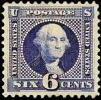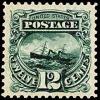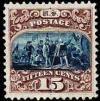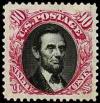Read an interview with the author of Alphabetilately at Marty Weil's Ephemera Blog
U.S. Commemorative Stamps
A "Commemorative Stamp" is one issued to honor a person or event. It is printed once, in relatively small quantities (typically 50 to 100 million in the U.S.), and withdrawn from sale (if not sold out) after a specified time, usually about a year. Or at least that's what it used to be - these days, with stamps for insects, aquariums, and dinosaurs, the definition has been stretched quite a bit. They usually make at least a pretense of a connection to U.S. history or culture, but let's face it, the name of the game is "market appeal".
Immediately below is a table with crude statistics for all U.S. postage stamps issued from 1847-1996, summarized by decade. Note that the number of commemoratives per decade remained relatively constant for the first forty years after their inception, then jumped dramatically.
|
Years |
Total Issues |
Defin's |
Commem's |
Other |
|
1847-56 |
7 |
7 |
0 |
0 |
|
1857-66 |
14 |
14 |
0 |
0 |
|
1867-76 |
33 |
33 |
0 |
0 |
|
1877-86 |
16 |
16 |
0 |
0 |
|
1887-96 |
48 |
32 |
16 |
0 |
|
1897-06 |
43 |
23 |
20 |
0 |
|
1907-16 |
35 |
25 |
10 |
0 |
|
1917-26 |
65 |
47 |
15 |
9 |
|
1927-36 |
133 |
25 |
94 |
14 |
|
1937-46 |
170 |
51 |
107 |
12 |
|
1947-56 |
149 |
25 |
110 |
14 |
|
1957-66 |
230 |
26 |
178 |
26 |
|
1967-76 |
265 |
49 |
163 |
53 |
|
1977-86 |
347 |
122 |
187 |
38 |
|
1987-96 |
398 |
157 |
179 |
62 |
I say these statistics are "crude" because I have ignored varieties, differences in format (I count a sheet version and a coil version of the same design as one issue), and philatelic issues such as souvenir sheets; and I have counted setenant issues by the sheet rather than by the design (so a sheet with twenty different stamps, such as the Legends of the West, is counted as one); and I have taken a few other liberties to simplify things. My goal was to show the way commemorative issues have increased over time. ("Other" is Airmail, Xmas, and Love issues.) Just for the record, compiling this list was not easy. The Linn's Stamp Almanac has such a table, but I could not reproduce their numbers, and wanted to count things differently. Try it yourself - how do you handle souvenir sheets, booklets, Love stamps, Xmas stamps, and all the special varieties? Is a perforation variety a new issue? What about a different format, such as a coil vs. a sheet? Should a sheet with twenty designs really count as twenty issues?
Below are some examples of commemoratives, sorted by date issued. As you can see, a lot has changed.
Click on any image below to view a high-resolution version.
Pictorial Issues of 1869
(NOT commemoratives)
Some people consider the set below (Scott 112-122) to be the first U.S. commemorative
stamps, because they pay tribute to historical events and American industry. But they
were intended as regular definitive issues, and that's what most people (and I) consider
them. The key fact to me is that they were the only stamps available at the time,
whereas a commemorative stamp is redundant with the definitives of its time.
These stamps were very unpopular when issued, I suppose because the concept of stamps was still a new one, and people expected the new ones to look like the old ones, with portraits of famous people, which most of these did not have. They were printed both with and without grills, so there are at least two versions of each, though I show only one. A full set of even the cheapest varieties will cost you several thousand dollars - used.
Columbian Exposition Issue - 1893
First true commemoratives
The first official commemoratives were the set below, Scott 230-245, issued in 1893 in
conjunction with the
Columbian Exposition in Chicago that year, and marking the
400th anniversary of
Christopher Columbus's voyages. There were SIXTEEN
stamps in the set, with denominations ranging from 1¢ to $5, and a total face value
of $16.34, an astronomical sum for the time, easily a week's wages for the average worker
- I'd say it's the equivalent of at least $500 today (See my discussion "So What's a Dollar Really Worth?"). Their cost
was an issue because there were already many stamp collectors, who wanted to own an
example of every stamp issued, and felt frustrated both by the prohibitive cost of a mint
set of the stamps, and the impossiblity of finding used examples of many of the higher
denominations. Today a set of these USED will cost you at least $2,000, while a mint
set will set you back at least four times that! While they look very old-fashioned and
quaint today, I think they make a beautiful set. Reproductions were issued on a set
of USPS souvenir sheets in 1992, in conjunction with the World's Columbian Stamp Expo '92 in Chicago,
commemorating the 500th aniversary of Columbus's first American voyage (a year early!). You
can see those HERE.
















Images courtesy of Shreves Philatelic Galleries.
12/04/2004 - NEW WEB SITE. I just discovered Nick Blackburn's very informative and entertaining site, with a page that lists (and shows) the first commemorative for every country -
http://www.snap-dragon.com/first_issues_guinness.htm - First issues by type for each country. The list is sequenced by date of each country's first postage stamp, and goes from Great Britain (1840) through Georgia (1995).
His very ambitious site shows great promise, so check it out regularly, and send him feedback to encourage his efforts. He and I are having a discussion about the terms setenant and composite right now - see my S page for more.
Trans-Mississippi Exposition Issue - 1898
Having established the precedent of issuing stamps to promote a large exposition, the USPOD had to issue a set for the next big U.S. expo, the Trans-Mississippi Exposition of 1898. This time they exercised a LITTLE more restraint - only nine stamps, with a total face value of ONLY $3.80. The $1 value, titled "Western Cattle in Storm", is considered by many the most beautiful classic U.S. issue - I'll let you be the judge of that. A good used set of these - Scott 285-293 - will set you back at least $1,000, while a mint set can run over $4,000. These too were issued in reproductions on souvenir sheets on their centenary.









Images courtesy of Shreves Philatelic Galleries.
Pan-American Exposition Issue - 1901
The next big U.S. expo was the Pan-American Expo of 1901. This time there were only six stamps, Scott 294-299, with a total face value of 30¢, and they were the first bi- color commemoratives. I've written a lot more about them here, on my Trains on U.S. Stamps pages. Note that they've added the text "Commemorative Series 1901" at the top of each stamp, emphasizing that these are Commemoratives! Only the invert errors were deemed important enough to reproduce when their centenary rolled around - Look HERE.






Click Here to visit my display of
Cinderella stamps from the Pan-Am Expo.
Louisiana Purchase Exposition Issue - 1904
The next big expo was in 1904, the Louisiana Purchase Exposition in St Louis (yes, it's the fair in the movie "Meet me In St Louis"). These five stamps, Scott 323-27, were issued to advertise it. The text "Commemorative Series of 1904" is there, but probably too small to read on these scans.Worn out already? The USPS has not re-issued these stamps this year, so I guess they've tired of the game. But surely they'll reissue the Panama-Pacific Expo stamps? Check back in 2013!
Jamestown Exposition Issue - 1907
In 1907 the Jamestown Exposition was held in Sewell's Point, Virginia to celebrate the tercentenary of the founding of Jamestown.Three stamps were deemed enough, with "Commemorative Series of 1907" at the top of each. Scott 328-330.
Lincoln Memorial Issue - 1909
Alaska-Yukon Issue - 1909
Hudson-Fulton Issue - 1909
1909 was the 100th aniversary of the birth of Abraham Lincoln. The first stamp below, Scott 367, was issued to commemorate that event. (The USPOD had finally decided the text "Commemorative Series" was pointless.)
That same year Seattle held an expo to advertise the Alaska Territory. The date seemed odd to me, but according to this page at Wikipedia: It was originally planned for 1907, to mark the 10th anniversary of the Klondike Gold Rush, but the organizers found out about the Jamestown Exposition being held that year, and rescheduled. The organizers of the Expo campaigned successfully for the second stamp below, Scott 370 - it shows William H. Seward, Secretary of State under both Lincon and Johnson, who had engineered the purchase of Alaska from Russia in 1867.
Finally, also in 1909,
The Hudson-Fulton Celebration was staged in New York Harbor.
This event was a combined celebration of Henry Hudson's discovery of the Hudson River in
1609, and Robert Fulton's historic steamboat voyage on the Hudson in 1809. The
celebration's backers persuaded the USPOD to issue the third stamp below, Scott 372. By
this time it was clear the cookie jar was open - anyone could get a
stamp issued to advertise their event.
Panama Pacific Exposition Issue - 1913
The Panama Pacific Exposition was held in San Francisco in 1915 to celebrate the completion of the Panama Canal in 1914. The celebration was a Very Big Deal, marking as it did such an historic achievement. In addition, the Expo was San Francisco's advertisement to the world that it had recovered from the 1906 earthquake. For these reasons the set below (Scott 397-404) was issued TWO YEARS before the expo even opened, in January, 1913, and remained on sale through the end of the expo. It was reprinted several times, and issued with two different perforations, so there are at least two versions of each stamp, though I show only one.(I found a wonderful pamphlet issued by San Francisco promoters to get their city picked as the locale for the 1915 Expo. Apparently there were other candidates. Click here to see it. )
Allied Victory Issue - 1919
World War I put a damper on the enthusiasm for fairs, expos, and the like. It was 1919 before the USPOD felt the urge to commemorate anything again, and the Allied Victory Issue below, Scott 537, was the popular choice. Ironically, the Post Office had been about to issue a set celebrating Peace in 1914, but decided against it when European hostilities heated up.
Pilgrim Tercentenary Issue - 1920
1920 was the three hundredth anniverary of the Landing of the Pilgrims in Massachusetts, and Plymouth, Mass. held a celebration.The USPOD was persuaded to issue the stamps below, Scott 548-550, to honor the event.
To my knowledge these stamps (and Scott 1208) are the only US postage stamps that do not have our country's name on them. This caused quite an uproar at the time. There was even a rumor the omission had been unintentional, and the stamps would be recalled and redone, but the USPOD denied any error, and issued this statement:
There is no necessity for the name, as the stamps are fully identified and authenticated to the postal service in a notice, of which a copy is attached. Any additional lettering would have overcrowded designs which required all of the spaces assigned to them.
- (Johl, The United States Commemorative Stamps of the 20th Century, Vol 1, p.75)
Aside from these, all US stamps, and those of all other countries, include the country name, EXCEPT for those of Great Britain. As the first country to issue postage stamps, Great Britain does not identify itself by name on its issues. Instead, a portrait of its ruling monarch is always included in the designs.
Harding Memorial Issue - 1923
Warren Harding died in office near the end of his term, in August, 1923. There were not yet any rules about when and how anyone could be honored on a postage stamp, so the Post Master General, who had been Harding's friend, issued the stamp below. It was the first time since Lincoln that a President had been honored so soon after his death, and I think it ironic that Harding, a mediocre President at best, got a stamp less than a month after he died, while Wilson, for example, a much greater man, was not so honored until a year and a half after his death.
Here is a table, sorted by date of death, showing the dates of birth, death, and memorial stamp for all deceased presidents since 1900. The stamp for Harding created a stir, resulting in a rule that all Presidents should be honored on a stamp within a year of their deaths, generally on the anniversary of their birth. The rule was suspended for Hoover (politics), and bent a little for Nixon (supposedly because of a pending rate increase in January). FDR was honored with a set of four stamps, released over a period of seven months following his death, and few then or now would suggest he did not deserve the honor. Ordinary mortals cannot be commemorated on a U.S. postage stamp until they have been dead for at least ten years. (Some people confuse "commemorated" with "shown". Living people have been shown on stamps, not to commemorate them personally, but to illustrate the stamp's subject.)
|
President |
Date of death |
Birth |
Stamp issued |
|
McKinley |
September 14, 1901 |
Nov 29 |
April 30, 1904 |
|
T. Roosevelt |
January 16, 1919 |
Oct 27 |
October 27, 1922 |
|
Harding |
August 2, 1923 |
Nov 2 |
September 1, 1923 |
|
Wilson |
February 3, 1924 |
Dec 28 |
December 28, 1925 |
|
Taft |
March 8, 1930 |
Sep 15 |
September 18, 1930 |
|
Coolidge |
January 5, 1933 |
Jul 4 |
November 18, 1938 |
|
F.D.R. |
April 12, 1945 |
Jan 30 |
June 27, 1945 |
|
Kennedy |
November 22, 1963 |
May 29 |
May 29, 1964 |
|
Hoover |
October 20, 1964 |
Aug 10 |
August 10, 1965 |
|
Eisenhower |
March 28, 1969 |
Oct 14 |
October 14, 1969 |
|
Truman |
December 26, 1972 |
May 8 |
May 8, 1973 |
|
Johnson |
January 22, 1973 |
Aug 27 |
August 27, 1973 |
|
Nixon |
April 22, 1994 |
Jan 9 |
April 26, 1995 |
|
Reagan |
June 5, 2004 |
Feb 6 |
Feb 9, 2005 |
Huguenot-Walloon Tercentenary Issue - 1924
1924 was the three hundredth anniversary of the embarkation of the ship "Nieu Nederland" from Leyden, Netherlands, carrying thirty-two families of French-speaking Protestant Walloon refugees fleeing religious persecution in Flanders, now a part of Belgium. Their landing in May is considered the founding of New Netherland, the original Dutch settlement in the New World, on Manhattan Island. This stamp was issued in conjunction with the tercentenary celebration.
US Commemoratives from 1925 onward
From 1925 forward, the USPOD (now the USPS) issued new commemoratives every year. For details on all of them visit 1847 USA, the premier online reference about stamps of the United States.
Send feedback to the author: CLICK HERE
Revised -- 01/27/2006
































